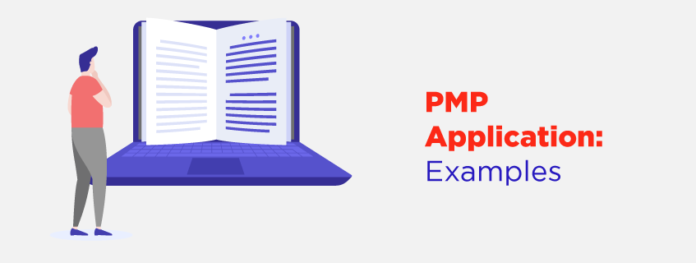Are you ready to dive into the thrilling world of PMP certification? Well, if you’ve ever attempted to fill out the PMP application and felt overwhelmed, worry no more. In this article, I will explain the entire PMP application process step by step and give you my best advice so you can smoothly sail through the PMP application process.
By the end of this article, you’ll have all the knowledge you need to conquer that application and take the first step toward realizing your PMP dream. I will also be spilling the beans on the common mistakes people make while filling out their PMP applications.
But before we dive into the nitty-gritty of the application process, it’s essential to understand the PMP exam eligibility. It is an important step, and you want to ensure you’re on the right track.
If you’ve obtained a four-year education degree, it is required to demonstrate 36 months of project leadership experience on your PMP application. Otherwise, individuals with a high school diploma or associate degree must exhibit 60 months of project leadership experience. Additionally, for both pathways, completing 35 hours of project management education or attaining the esteemed CAPM certification is mandatory.
My recommendation would be that before you dive into the PMP application form, you download and thoroughly read through the PMP exam content outline and the certification handbook. It is an excellent resource, and the certification handbook is your ultimate guide to everything you need to know about applying for the PMP while the exam content outline is like a map that explains all the necessary details about the exam, like the topics, tasks, and other relevant information.
However, let’s first understand the process of completing the online PMP application.
I’ve divided the entire process into two stages to help you understand better. The first stage deals with filling out and submitting the application, and the second part deals with what happens post application submission.
Step-by-step process to apply for the PMP exam:
- Stage One: Filling and Submitting the Application
- Creating a PMI account is mandatory to access the application form. So, the first step is to register your personal PMI account, which you can do for free. Your free account can be created by registering on the PMI website.
- You’ll need to fill in all your details, such as your name, email, country, company name, job title, date of birth, experience, and project management details in your career and organization.
- Add your account information and hit Create Account. Once registered, go to the certification tab and select Project Management Professional. This will take you to the PMP page.
- Click on ‘Apply now’ for your PMP to go to the PMP application form. The application form will be divided into three sections: education, experience, and exam details.
Academic Education Section:
In academic education, enter the highest level of education you have attained by selecting from the dropdown. This can be a high school diploma, associates, bachelor’s, or master’s degree, or even a doctorate. Fill in the years attended, country, and name of the institution. Select the field you studied from the dropdown. So, it can be business, finance, marketing, or anything else.
Click ‘Save Education’ once you’ve entered all the necessary details.
Professional Education Section:
In the professional education section, you need to:
- Enter the course details you took to complete the required 35 hours of project management education. This can also be a PMP certification course that you sat for.
- Click Save Education again once you’ve filled in these details.
The green check mark indicates that you’ve entered all the information correctly.
Remember that if your project management training does not meet the mandated 35 hours of project management education requirement, your application will get rejected. You don’t have to upload any documents or any training certificates, for that matter, at this stage. These have to be uploaded only at the time of a PMP audit.
Experience Section:
We will now move on to the experience section, which is the second part of the application process, where you’re required to fill in your project management experience. This may be the most challenging part of the application, but it is crucial to complete it with utmost care so that your application is accepted.
Enter the project title and the organization. The project title is a label for the Project and must be a high-level title of the Project, such as ‘Product Development project’ or ‘Process improvement project’.
For the job title, you can write Project Lead or Project Manager.
Enter your functional reporting area, which is the department of the organization where the Project was carried out, and the organization’s primary focus is the industry or sector of the organization.
The approach methodology can be agile, waterfall or hybrid, and you also need to enter the team size and budget information.
While filling out project dates, remember that you should not provide overlapping months of experience. But let’s understand the meaning of overlapping experience with an example. Let’s say you worked on two projects between January and December 2022. Project One ran from February 1st to August 31st, 2022. Project two started on June 1st and ended on November 30th, 2022. It’s evident that these two projects overlap from June to August.
However, you can’t list this overlapping experience twice in your PMP application. So, to avoid the overlap for Project One, you would list the dates as February to August. For Project Two, you would list it as September to November. Remember, we want to provide clear and non-overlapping information in the experience section of your PMP application.
Now, let’s look at the project description section more deeply with the help of an example. This section holds significant weight, as it is a critical factor that can lead to PMI rejecting applications if not written correctly. Poorly written project descriptions can also trigger a PMP application audit.
PMP project description example
Project Objective: The goal of the Project was to create an e-commerce engine for ABC computers in the APAC region, enabling users to simplify shopping and increase the company’s revenue.
Project Outcome: The e-commerce engine was made available for users in the APAC region, allowing them to shop online for ABC computer’s services.
My Role in the Project: As the Project Lead, I oversaw the entire Project and led the team through all the stages of the Project’s life cycle. During initiation, I identified stakeholders, created the strategy and WBS, and secured key stakeholders’ agreements.
In the planning stage, I developed a job responsibility matrix and project plan, considering time, expense, and performance.
In the execution phase, I oversaw the development of the portal with cross-functional teams.
During the monitoring and controlling phase, I ensured all milestones were met on time, developed weekly status reports to update team members and management, and monitored the Project’s progress.
In the closing phase, I released the Project to users after meeting all acceptance criteria, preserving project documents and materials through accepted practices, and obtaining approval for project deliverables to meet legal obligations.
Note: PMI seeks experience that illustrates how you fit the project manager’s requirements, so use PMBOK guide terminology in your description to show adherence to best practices.
Once you enter the first project details, you can save the experience and move on to adding ‘additional experience.’ You need to repeat this process for each project led until you reach the 36- or 60-month experience requirement.
How to Fill the Project Description: Tips for success
- Stick to PMI’s recommendation of keeping the description between 200 and 500 words.
- Ensure project descriptions satisfy PMI’s criteria by demonstrating accomplishments across all project management life cycle stages and performance domains.
- Focus on your role, emphasizing what you did as a project manager and highlighting achieved deliverables.
- Ensure your project experience or education meets the required hours specified by PMI.
Follow the tips above as you write your description to make your application succeed.
If, at any time, you want to leave off and come back to the application, you can do so by going to My Certifications and clicking on “Continue Application.”
Final section of the PMP Application
The final section of the PMP application form is the exam details, for which you need to provide all the required information. For my example, you can choose the United States as the exam location, and you need to include your address, email address, phone number, and name in this section. Make sure to provide accurate contact details in this section, as you would want it to appear on the certificate.
Next, if you need exam accommodation, review to ensure that you have entered all the information accurately.
As a final step, check these boxes to verify that the information you provided is accurate and click submit to submit your application. Once you hit submit, the first stage of the PMP application process is complete.
Keep in mind that after you submit, you may see either a message stating that your details are under review or if you’ve been chosen for a PMP audit, the screen will display, ‘Your PMP Application is selected for an audit.’
Post-PMP Application submission stage
The second stage of the process starts with the application review by PMI. In around five to seven days of submission, PMI will let you know whether your application has been selected for an audit or not. If not, then you can pay the fee, and schedule the exam.
Common PMP Application questions
- Will my PMP Application get rejected if my job title is not project manager?
No, your application will not be rejected solely based on your job title not being “project manager.” PMI does not mandate a specific job title. However, it’s crucial to emphasize in your application that even if your official title isn’t “project manager,” you have undertaken the responsibilities and played the role of a project manager or lead in the projects you describe. The key is to highlight your project management experience and contributions in your role.
- How can I avoid or prevent a PMP audit?
Now, there is no way to escape an application audit, as PMI reserves the right to randomly pick any application for this process. However, to pass the audit process successfully, ensure you use PMBOK guide terminology and language in your project descriptions for clarity. PMI seeks experience reflecting project manager requirements to avoid audit failures.
- How many days do I have to complete the PMP application process?
Once you kick off the process of filling out the online application form on the PMI website, you’ve got a 90-day timeframe to submit it.
- I am nervous about getting selected for a PMP audit? How can I pass it without any hassle?
If you land up being one of the chosen ones for a PMP application audit, do not panic. Just focus on providing PMI with what they need to complete the audit process.
For your academic evidence, you need to submit copies of your degree or diploma. For your PM experience, you’d need to provide the name of your contact or manager in charge of the project so that they can validate your experience. Further, do not worry if your manager has left the organization; you can take similar evidence signed from your peers or even your team members. You will have 90 days to complete and submit your audit paperwork through your PMI account under application status.
Audit materials are processed within five to seven business days of their submission. Once you pass the audit, hey, you can go ahead and complete the exam fee and scheduling formalities.
Closing Recommendations for Application success:
- Provide factual and accurate information in your application.
- Ensure you’ve obtained your 35 hours of project management education from a reputed and licensed organization.
- Highlight projects where you were the project manager or lead in the project description section. Remember the requirement is to demonstrate experience in managing and leading projects even if you don’t have a specific PM designation.
- Inform your references that PMI may contact them during the audit process.
- Pick an exam date once your PMP application is approved. That will motivate you to work harder and, most importantly, prevent procrastination.
Final steps: Scheduling the PMP exam
Once your application is approved, the next step is to pay the exam fee. Now the fee amount depends on your geographical location and whether you’re a PMI member or not. In North America, the fee is $405 USD for PMI members and $555 USD for non-members.
It is highly recommended to start preparing for the exam before you schedule it. I suggest checking out CareerSprints.com and their PMP Blended Program. It comes with coaching, mentorship, assistance with your PMP application, study materials, practice papers, cheat sheets, and PMP exam mindset documents. Their comprehensive program can help you succeed in the PMP at a more affordable cost than a traditional PMP Boot Camp.
Write and Win: Participate in Creative writing Contest & International Essay Contest and win fabulous prizes.











